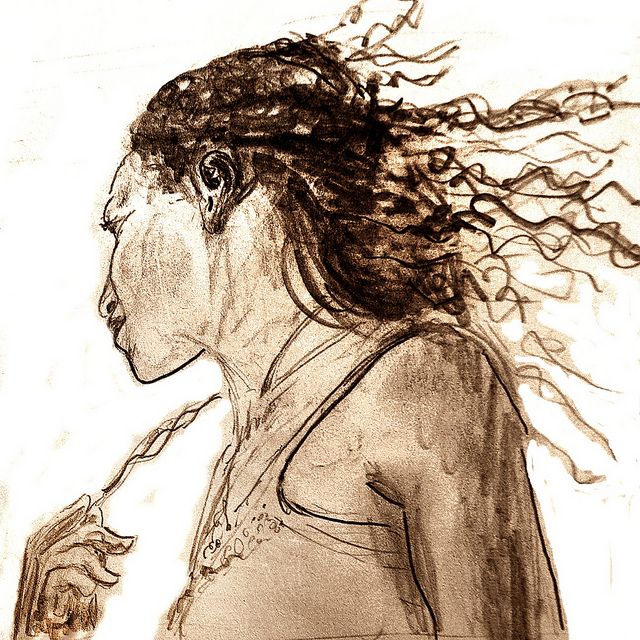
I pull out my hair.
It’s a problem that’s plagued me since my early teenage years.
My whole life, I watched my mother systematically pull out her hair. She’d sit on the couch reading her book and mindlessly pull out her hair piece by piece. I judged her for this repulsive habit. I certainly never suspected that I’d fall victim to the same disgusting routine myself.
I’ll never forget the first time I pulled out my hair. I was sitting in Algebra II class feeling totally stressed out. Not conscious of what I was doing, I reached my hand up to my head and felt around for a particularly curly piece of hair. I stroked the length of it a few times, enjoying the feeling of its bumpy texture. Before I knew it, I tugged it a bit too hard, and voila, I pulled it out. I was surprised to experience the sense of relief it gave me during this stressful moment. This good feeling was mixed with a tiny moment of pain.
I easily fell into the habit of pulling out my hair while doing school work. The stress relief it provided was nice, but it was paired with the extreme shame of involving myself in an obsessive uncontrollable habit. I’m sure others did not notice this behavior much, but it made me feel like I was making a spectacle of myself. And it would leave me with small bald spots. But the hair always grew back during less stressful times.
The problem of pulling out my hair has afflicted me off and on since then. It’s been something I’ve always hated about myself and wanted to stop doing.
Which has been easier said than done.
Obsessive hair-pulling falls into the category of obsessive body-focused repetitive behavior. Hair-pulling is similar to nail-biting and skin-picking. About 10% of the population suffers from hair-pulling—it is called trichotillomania. Hair-pulling occurs on the scalp, eyebrows or eyelashes.
The first week of October is Trichotillomania Awareness Week.
It is a troublesome disease to diagnose with no cure. I’ve done a ton of research about what causes hair-pulling and ways to modify my behavior. Unfortunately, there is not a lot of information, and I’ve tried lots of “remedies” with some success but no lasting results.
The best course of action to help me not pull out my hair is radical self-acceptance, mixed with keeping a daily tally of my success.
1. Accepting the fact that I pull my hair out has been the most helpful thing to keep me from doing it. This allows me to celebrate days I do not pull my hair, but also allows me to love myself on days when I am less than perfect and happen to pull a hair out.
2. Making a conscious decision to not pull out my hair is the first step. Keeping careful track of my behavior is key. I also pay attention to the feelings in my body before, during and after hair pulling.
3. Keeping myself accountable for not pulling out my hair is not easy. The best trick I’ve found for making sure I don’t do it is to admit to another person that I have a problem, share my plan to stop pulling my hair out and report to them daily about my progress. It makes me feel proud to report my success and it’s comforting to have a cheerleader holding me accountable.
When I found out that the worst side effect of pulling out my hair is decreased self-worth, which can lead to depression, I made a commitment to protect myself from self-harm.
4. Keeping track of my success really helps me not pull out my hair. Some sufferers of this disorder have decreased the incident of hair-pulling by keeping a journal. This is an amazing idea, but journaling is not my thing. Instead, I took inventory of when and where I pulled my hair out the most often. During stressful times at work is where I noticed my hair-pulling the most. So I made myself a little paper heart that I keep tucked into my laptop everyday, and I add a tally mark for each day I do not pull out a hair. It’s funny that such a little thing makes such a huge difference. If I get the urge to pull, the heart sitting on my desk reminds me to be gentle with myself and not pull out a hair because it will hurt me.
5. Meditation. A daily meditation practice is known for creating new neural pathways in the brain. When we’re trying to stop an obsessive behavior, it is super helpful to get a mental break from it. A meditation practice helps us to create new ways for our brain to think. During meditation, I briefly picture my neural pathways as a well-worn foot path through a grassy field. I picture myself standing still and not traveling down that path while new grass grows along it. And then I am free to take a new path instead of the old obsessive one. Over time, the well-worn footpath of my obsessive behavior will be completely overgrown.
6. Finding healthy alternatives to stress relief. Practicing healthy stress relief is easy and fun—walking, biking, laughing, dancing, cooking, taking Epsom salt baths and sex.
I know that hair pulling is a problem that will plague me every day the rest of my life. But I also know that the days I succeed at not pulling out my hair will add up and I will celebrate my self-control and self-love.
~
Author: Ashleigh Hitchcock
Image: flickr/JackWolf


 Share on bsky
Share on bsky




Read 0 comments and reply